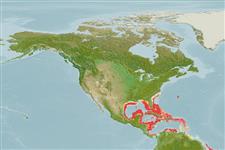>
Anguilliformes (Eels and morays) >
Nettastomatidae (Duckbill eels)
Etymology: Nettastoma: Greek, netta = duck + Greek, stoma = mouth (Ref. 45335); syntresis: From the Greek syntresis meaning channel, passage, strait, referring to the Santaren, Nicholas and Northwest Providence Channels, places where it has been found. Noun in apposition..
Environment: milieu / climate zone / depth range / distribution range
Ökologie
seewasser bathydemersal; tiefenbereich 0 - 641 m (Ref. 40819). Deep-water
Western Central Atlantic: off the Bahamas and Cuba and in the northeastern Gulf of Mexico.
Size / Gewicht / Alter
Maturity: Lm ? range ? - ? cm
Max length : 55.0 cm SL Männchen/unbestimmt; (Ref. 37039)
Wirbelzahl: 201. Normally 6 supraorbital pores, SO5 present. Lateral line pores 38-41. Median vomerine teeth not enlarged. Posterior nostril near anterodorsal margin of eye. Other characteristics: Color brown to gray, with vertical fins edged in black (Ref. 37039).
Minimum depth from Ref. 58018.
Life cycle and mating behavior
Maturities | Fortpflanzung | Spawnings | Egg(s) | Fecundities | Larven
Smith, D.G., J.E. Böhlke and P.H.J. Castle, 1981. A revision of the nettastomatid eel genera Nettastoma and Nettenchelys (Pisces: Anguilliformes), with descriptions of six new species. Proc. Biol. Soc. Wash. 94(2):535-560. (Ref. 40819)
IUCN Rote Liste Status (Ref. 130435)
Bedrohung für Menschen
Harmless
Nutzung durch Menschen
Tools
Zusatzinformationen
Download XML
Internet Quellen
Estimates based on models
Preferred temperature (Ref.
123201): 13.4 - 25.3, mean 19.6 °C (based on 123 cells).
Phylogenetic diversity index (Ref.
82804): PD
50 = 0.5312 [Uniqueness, from 0.5 = low to 2.0 = high].
Bayesian length-weight: a=0.00089 (0.00036 - 0.00223), b=2.98 (2.77 - 3.19), in cm total length, based on LWR estimates for this (Sub)family-body shape (Ref.
93245).
Trophic level (Ref.
69278): 3.4 ±0.5 se; based on size and trophs of closest relatives
Widerstandsfähigkeit (Ref.
120179): mittel, Verdopplung der Population dauert 1,4 - 4,4 Jahre. (Preliminary K or Fecundity.).
Fishing Vulnerability (Ref.
59153): Moderate to high vulnerability (47 of 100).
